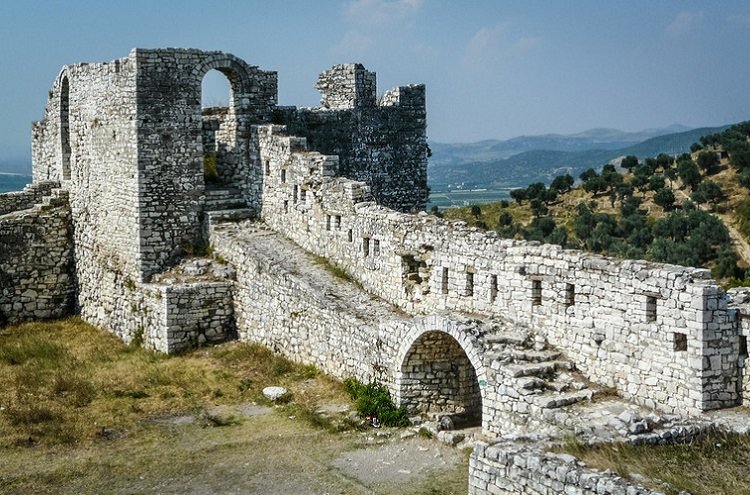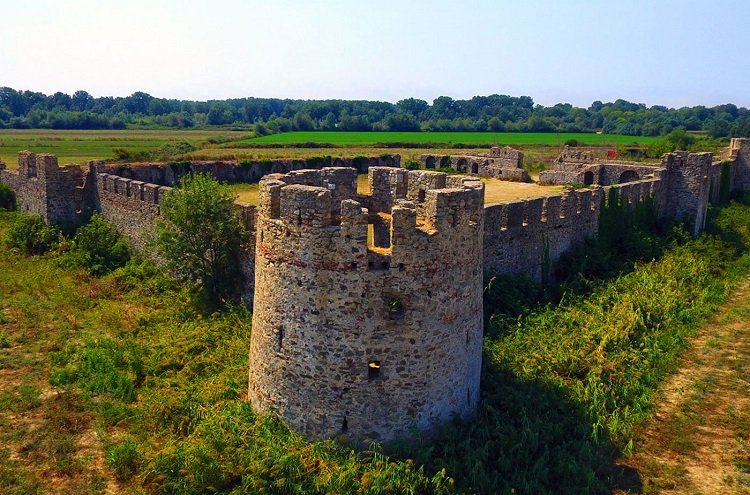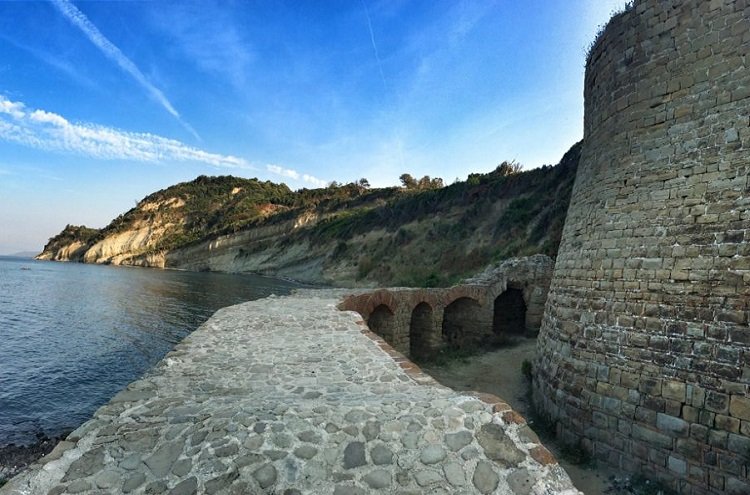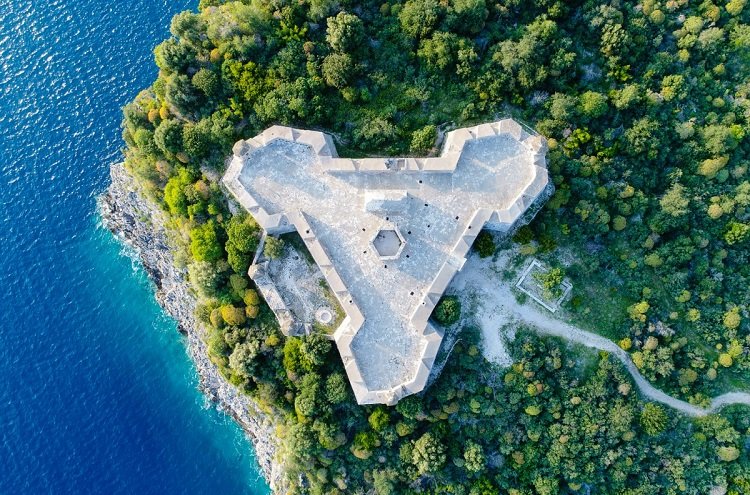
Albanian Castles: Top 10 Castles to Visit in Albania
Albanian castles are among the oldest in the Balkans. Countless old castles and fortifications pop up across the country, best representing its rich heritage; here is a breakdown of Albania’s most important castles.
1. Castle of Kruja
Castle of Kruja is one of the most visited cultural sites in Albania. This mighty fortress served as the epicenter of Gjergj Castriot’s (Gjergj Kastrioti) resistance against the vast and frequent Ottoman armies. The castle was first erected in the V-th century during the Byzantine era. Later, it was baptized in war against the Ottomans during the XV-th century. The stronghold resisted three prolonged sieges which gave Kruja its national gravity it still has.
Within the castle’s walls, visitors can go through a museum dedicated to the deeds of Gjergj Castrioti (where a bell of 1462 stands out), an Ethnographic museum of unique value, old ruins of a church, a still-standing old tower, Ottoman baths, and many other attractions; all in an environment organized in terraces and adorned by beautiful gardens, olive groves, old wells, and traditional restaurants.

2. Rozafa Castle
Rozafa castle stands proud over a rocky hill above the northern city of Shkodra. Its outer walls follow the fluid terrain of the hill and cover in them some 9 ha of land.
Once you enter the main gate, fortified during the XV-th century, you’ll come to a courtyard. This is the oldest part of the castle. A tract of an Illyrian wall of the IV-th century B.C.E., stands out in this section. Other attraction in this section include ruins of Medieval cisterns, towers of the Balshajt noble family, and “Venetian” residences.
Another gate gives access to the second section via the first section. Here you can witness the ruins of the Saint Stephen church, a romantic style building belonging to the XIII-th-XIV-th centuries. This structure turned later into the Sultan Mehmet Fatih Mosque.
The third section known as the “Capitol” marks the climax of the tour. This served once as the of the Venetian ruler. Here you can enjoy the stunning views of the area below the castle. Below, the three major rivers of Kir, Drin, and Buna, as well as the Shkodra lake embrace the castle’s foothill.

3. Berat Castle
Berat castle rises over a hill 187 metres (613 feet) high above the authentic city of Berat. The fortification, east of Osum river, dates from the IV-th century B.C.E., reflecting traces of Illyrian civilization.
The castle’s outer stone walls cover a distance of 1,440 meters (4,724). Along these walls stood 24 watchtowers for added defense, and two main gates for access.
Within its walls, inhabitants continue to live freely in their own private houses as they did centuries ago. Berat’s castle is famous for its 14 churches of the Byzantine period and the fresco-adorned museum of the renowned Albanian painter Onufri.

4. Castle of Gjirokastra
Castle of Gjirokastra is one of the largest castles in the Balkans. This iconic fortress rises dramatically over the stone city of Gjirokastër dominating it and the nearby Drino valley from a rocky hill more than 300 metres (984 feet) high. The origin of this fortification shifts back and forth from facts to myths. Historians suggest that the earliest construction phase was conducted during XII-th-XIII-th centuries. According to a local legend, this castle was named after a heroic native princess called Argjiro who jumped from the high walls with her child to escape the Ottoman invasion and persecution. Nowadays, visitors can witness the castles’ thick stone walls along steep cliffs, interior massive galleries that echo a history of struggle and resistance, open courtyards from where to observe amazing views of the city and valleys below, and many other twisting paths along the unresolved mysteries of a time-capsule monument.

5. Bashtova Castle
Bashtova castle is a cultural gem hidden in plain sight. Located in Vilë-Bashtovë, the construction is visible from afar for its round towers, turrets, and shape.
This XV-th century construction is among the rarest castles in the country constructed in flat land. It is believed that the fortification was initially built as a protected port along the Shkumbini river, important for the trading of cereal.
Bashtova’s presence is first documented as “Pastova” in a map of 1521 of Piri Reis. Although clearly showing the burden of centuries. Time has clearly taken her toll on the integrity of the Bashtova castle. Yet, the fortress promises a striking impression of nature combined with an aesthetically pleasing cultural legacy.

6. The “Venetian” Castle at Butrint
The so-called “Venetian” castle of Butrint guards the acropolis of what was once an important and prosperous settlement. This structure is just one of the countless monuments that still stands in the wonderful isle of Butrint. As for this castle itself, it gained its current shape during the waves of Anjou adventures (1269-1350). Soon after, it was the Venetians who gave it the refinements and structural cohesion it still reflects.
Beautiful gardens and courtyards around this castle, regular stairs up the structure, and charming pavements here-and-there are ideal to enjoy the picture-perfect landscape of the entire isle and lagoon.

7. Rodon Cape’s Castle
Skanderbeg’s castle (“Kalaja e Skënderbeut”) stands lonely at the tip of the Rodon’s cape, north of Durrës. This pristine place was a construction initiative of Gjergj Kastrioti Skënderbeu, Albania’s famous historical figure. During the 1450-1452, masters from Raguza worked on this isthmus to erect one of the most beautiful fortifications in the region. In about 1500, the Venetiants took over the site before leaving it to the Ottomans.
In time, erosion mastered parts of this place, sinking some of the walls under the waves of the Adriatic. Thankfully, tourists can still enjoy the remaining parts of the castle where wild vegetation, architectural legacy, and marine activity blend together. Visitors can reach this site either by sea using the small boats of local fishermen or through a trail meandering along the small peninsula.

8. Castle of Porto Palermo
The castle of Ali Pasha in Porto Palermo is an underrated piece of old architectural and engineering excellence. Located just south of Himarë, this site is easily the crown jewel of the Albanian Riviera.
As the name tells, Ali Pashë Tepelena, the local, controversial governor during Ottoman era, constructed this fortress. An artificial narrow passage connects the mainland with the isle where the castle stands, passing at the flank of the Porto Palermo’s Bay and through Mediterranean bushes and wild, short vegetation.
After entering the premises a different experience begins: that of shady mazes, dark empty chambers, and surreal salons. A staircase leads the visitors into the terrace that returns them into the outdoor atmosphere. This is also the best part of the guide where tourists can enjoy the 360 degree views of the twinkling Ionian waves and smooth deforested mainland hills.

9. Castle of Petrela
The castle of Petrela stands on a hilltop just south of Tirana, Albania’s capital. This intriguing building is worth a visit from the many tourists staying at the capital as it is just 14 km (8.6 mi) away from its center and super easy to access. The main road of Petrela’s village brings visitors just a few meters below the castle’s entrance. As visitors hike up the stairs and cycling path, the fairly small castle appears like it’s increasing in size. Once into the peaking fortification, you can explore the bizarre half-squared side tower, wander around the old cellars, or gaze at the pastoral sceneries from the side turrets. Petrela’s castle dates back since the V-th century but it gained the current shape during Medieval times. The typical middle age architectonic flavor combined with the rural background takes visitors back into some sort of imaginary Crusade-like time.

10. Castle of Elbasan
Elbasan’s castle is the largest among Albanian castles that stands on flat ground. It was first established in the beginning of the III-rd century C.E. around the Via Egnatia as the main protected outpost along this route, with a surface of 10 ha.
The wars of the IV-th and V-th centuries caused destruction in the settlement. Thus, emperor Justinian carried out its reconstruction. During the wars between Albanians and Ottomans, Mehmet the Conqueror realized its valuable strategic position and tried with mixed success to turn it into an Ottoman base against the Albanian League.
Currently, the castle of Elbasan impresses visitors with its long tall and straight walls, round bulky towers, and organized planimery. Private houses with citizens inhabiting them and internal alleys within premises give a friendly tone to this monumental complex.










Beautiful @ well preserved .. but – Albania has been established 108 years ago.